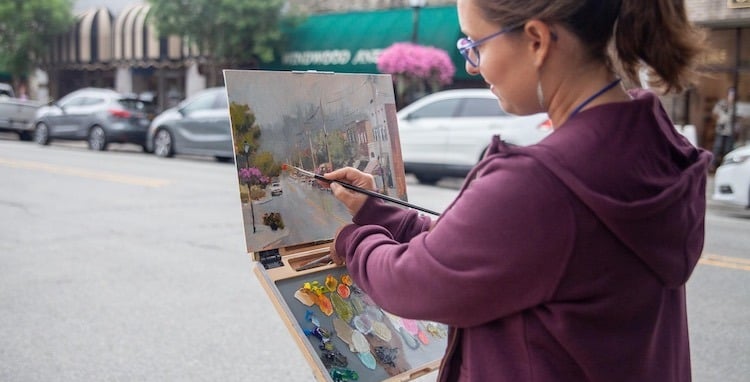Rachel Dowd Fine Art - Contemporary Impressionsim
Plein Air Equipment
My tools for success in the field...


As a plein air artist, my equipment can either make or break my painting experience and I have shared everything I bring with me to make your decision on what is best for you a little easier. The equipment you choose for plein air painting depends on your preference and style of painting. Through trial and error I have figured out that this minimal setup is the best option for me. I enjoy keeping it as simple and as easy to set up as possible. Using a minimal setup for plein air painting can be a great way to simplify your process, focus on the essentials, and create paintings that capture the essence of your subject. Give it a try and see how it can transform your painting experience! Happy painting!
Easel: I use a U.Go Plein Air Pochade Box by New Wave Arts in the 11x14" size. I love how it doesn't have knobs and buckles all over it. It stays open with friction hinges and all the moving parts are held in place with super strong earth magnets. So simple! It comes with a white plastic removable palette or you can use a gray glass palette. Both are very nice. I prefer painting on the glass, but I've found that it is pretty slippery and my leftover paint slides around on it when I'm traveling sometimes. I've been using the white plastic palette that it comes with more lately and my paint stays put. I also purchased the tray that fits on the side of the box to hold extra brushes. Worth it!
Tripod: I use a SIRUI AM-005K Alluminum Lightweight tripod. It's so small I can zip it up inside my backpack along with all my other equipment and it only. weighs 3lbs! It is available on Amazon.
Painting Surface: I almost always use Centurion linen panels in both oil and acrylic primed surfaces. When plein air painting I paint smaller so I can capture the scene quickly. My go-to sizes are 8x10, 9x12, and 12x16. I will occasionally use smaller or larger sizes.
Paints and Brushes: I carry a limited set of paints and brushes to avoid the burden of carrying too much. I bring a total of eight colors and maybe five or six brushes wrapped in a canvas brush holder. If you are interested in my specific paints and brushes, you can find that information by clicking here.
Solvent and Medium: I only use Gamsol while plein air painting and I keep it in a handy travel container that I hang off the side of my pochade box. I use it to both thin my paint and clean my brushes.
Sun Protection: I always bring a wide brim hat to wear even when it's cloudy or rainy because it shades my eyes and so my pupils open up a little more and I have an easier time seeing values and colors. On hot, sunny days I will bring a small bottle of sunscreen too.
Paper Towels and Trash Bag: I bring a roll of Viva paper towels with me as well as a plastic grocery bag for trash. I hang the grocery bag from a hook at the top of my tripod.
Value sketching tools: I bring 5 gray markers and a sketchbook to do a few quick value studies before I begin painting. My favorite markers are Copic markers in varying shades of neutral gray.
Two small tools: Inside my pochade box I put a basic palette knife for scraping my palette and a Kemper tool for signing my wet painting when I'm finished.
Water bottle and snacks: It's always a good idea to stay hydrated and energized!
Occasional extras: Sometimes, depending on the weather or the location I will bring some extra items such as bug spray, ear muffs for cold winds, hand and foot warmers, extra jacket/coat, etc. Basically whatever extra items I think will help me be successful in the field, but only if they are absolutely necessary.